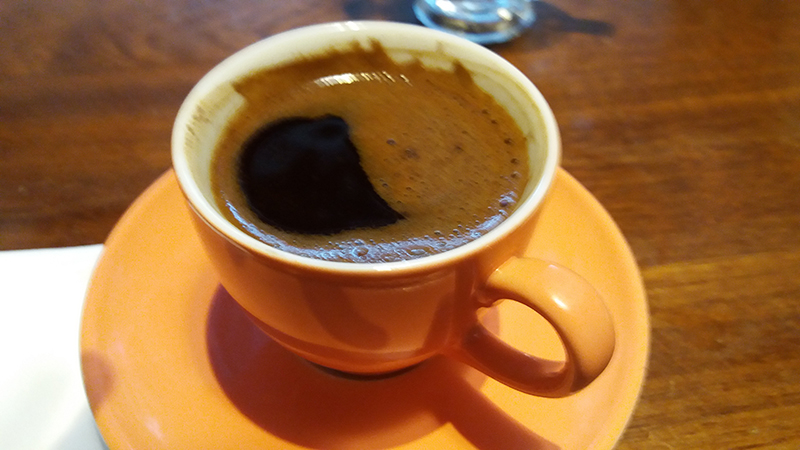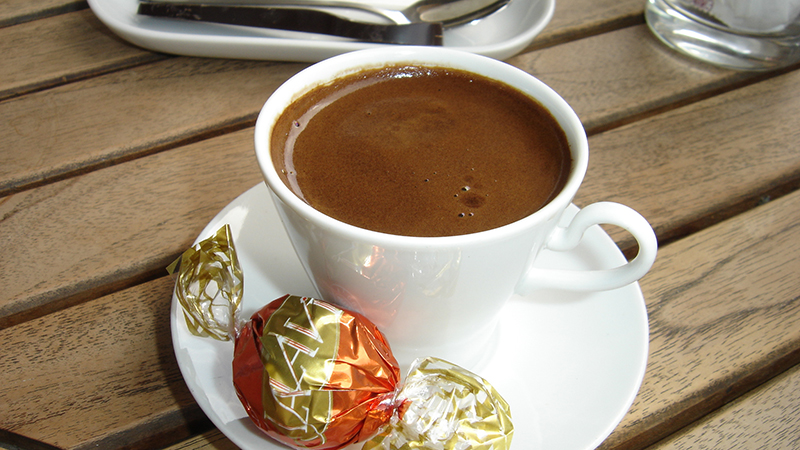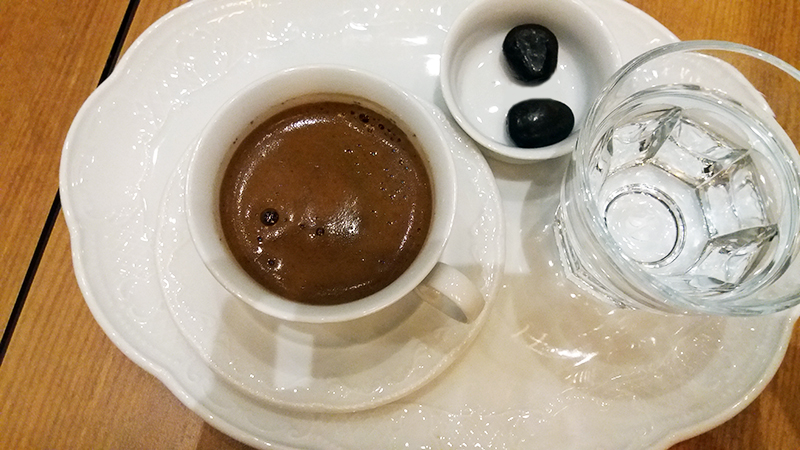
Coffee Trivia

1. Coffee was first known in Europe as Arabian Wine.
2. The Arabs are generally believed to be the first to brew coffee.
3. Milk as an additive to coffee became popular in the 1680’s, when a French physician recommended that cafe au lait be used for medicinal purposes.
4. The first Parisian cafe opened in 1689 to serve coffee.
5. Bach wrote a coffee cantata in 1732.
6. In the year 1763, there were over 200 coffee shops in Venice.
7. The heavy tea tax imposed on the colonies in 1773, which caused the “Boston Tea Party,” resulted in America switching from tea to coffee. Drinking coffee was an expression of freedom.
8. The founding fathers of the U.S., during the revolution, formed their national strategies in coffeehouses.
9. In early America, coffee was usually taken between meals and after dinner.
10. In the year 1790, there were two firsts in the United States; the first wholesale coffee roasting company, and the first newspaper advertisement featuring coffee.
11. The prototype of the first espresso machine was created in France in 1822.
12. By 1850, the manual coffee grinder found its way to most upper middle class kitchens of the U.S.
13. The Civil War in the United States elevated the popularity of coffee to new heights. Soldiers went to war with coffee beans as a primary ration.
14. In 1900, coffee was often delivered door-to-door in the United States, by horse-pulled wagons.
15. The first commercial espresso machine was manufactured in Italy in 1906.
16. In Italy, coffee and espresso are synonymous.
17. The average age of an Italian barista is 48 years old. A barista is a respected job title in Italy.
18. Italians do not drink espresso during meals. It is considered to be a separate event and is given its own time.
19. In Italy, espresso is considered so essential to daily life that the price is regulated by the government.
20. Italy now has over 200,000 coffee bars, and still growing.
21. In Greece and Turkey, the oldest person is most always served their coffee first.
22. In the ancient Arab world, coffee became such a staple in family life that one of the causes allowed by law for marital separation was a husband’s refusal to produce coffee for his wife.
23. Raw coffee beans, soaked in water and spices, are chewed like candy in many parts of Africa.
24. In the last three centuries, 90% of all people living in the Western world have switched from tea to coffee.
25. Coffee represents 75% of all the caffeine consumed in the United States.
26. Those British are sophisticated people, in almost everything except their choice of coffee. They still drink instant ten-to-one over fresh brewed.
27. Japan ranks Number 3 in the world for coffee consumption.
28. In Japan, coffee shops are called Kissaten.
29. Over 10,000 coffee cafes plus several thousand vending machines with both hot and cold coffee serve the needs of Tokyo alone.
30. For reducing wrinkles and improving their skin, the Japanese have been known to bathe in coffee grounds fermented with pineapple pulp.
31. The world can be divided into nations of coffee drinkers and nations of tea drinkers.
32. The average annual coffee consumption of the American adult is 26.7 gallons, or over 400 cups.
33. In 1990, over 4 billion dollars of coffee was imported into the United States.
34. Coffee is the most popular beverage worldwide with over 400 billion cups consumed each year.
35. Coffee, as a world commodity, is second only to oil.
36. Only about 20% of harvested coffee beans are considered to be a premium bean of the highest quality.
37. The Arabica is the original coffee plant. It still grows wild in Ethiopia.
38. The 2,000 Arabica coffee cherries it takes to make a roasted pound of coffee are normally picked by hand as they ripen. Since each cherry contains two beans, it takes about 4,000 Arabica beans to make a pound of roasted coffee.
39. Coffee sacks are usually made of hemp and weigh approximately 132 pounds when they are full of green coffee beans. It takes over 600,000 beans to fill a coffee sack.
40. Until the late 1800’s, people roasted their coffee at home. Popcorn poppers and stove-top frying pans were favored.
41. Citrus has been added to coffee for several hundred years.
42. The Europeans first added chocolate to their coffee in the 1600’s.
43. Frederick the great had his coffee made with champagne and a bit of mustard.
44. In the year 1809, Meslitta Bentz made a filter out of her son’s notebook paper, thus inventing the world’s first drip coffee maker.
45. Our sense of smell, more than any of our other senses, makes our final judgement on coffee.
46. Coffee, along with beer and peanut butter, is on the national list of the “ten most recognizable odors.”
47. Coffee lends its popularity to the fact that just about all flavors mix well with it.
48. Nomadic tribes preserved the coffee cherries to transport them long distances.
49. A four verse poem to coffee was written in Mecca in 1511. It was one of the first.
50. It was the early 1400’s, and with alcohol forbidden by the Koran, coffee soon became the replacement beverage.
51. Finely grinding coffee beans and boiling them in water is still known as “Turkish Coffee.” It is still made this way today in Turkey and Greece or anywhere else Turkish Coffee is served.
52. In the 14th century, the Arabs started to cultivate coffee plants. The first commercially grown and harvested coffee originated in the Arabian Peninsula near the port of Mocha.
53. In 1554 in Constantinople, two coffeehouses opened. They did very well. Soon there were many.
54. By 1600 A.D., coffee drinking had come to the Orient. It soon became very popular.
55. The Venetians first introduced coffee to Europe in 1615.
56. Lloyd’s of London began as Edward Lloyd’s coffeehouse.
57. It was during the 1600’s that the first coffee mill made its debut in London.
58. In 1670, Dorothy Jones of Boston was granted a license to sell coffee, and so became the first American coffee trader.
59. William Penn purchased a pound of coffee in New York in 1683 for $4.68.
60. Adding sugar to coffee is believed to have started in 1715, in the court of King Louis XIV, the French monarch.
61. The year was 1716 when Venetian coffee shop merchants began distributing leaflets exalting their new product: coffee. This may be the first example of advertising for coffee shops.
62. In 1727, as a result of seedlings smuggled from Paris, coffee plants first were cultivated in Brazil. Brazil is presently by far the world’s largest producer of coffee.
63. Before the first French cafe in the late 1700’s, coffee was sold by street vendors in Europe, in the Arab fashion. The Arabs were the forerunners of the sidewalk espresso carts of today.
64. The vacuum pack, invented in 1898, made it possible to preserve roasted coffee. Preserved coffee, though, not fresh coffee.
65. Espresso is to Italy what champagne is to France.
66. The French philosopher, Voltaire, reportedly drank fifty cups of coffee a day.
67. Retail espresso vendors report an increase in decaffeinated sales in the month of January due to New Year’s resolutions to decrease caffeine intake.
68. Scandinavia has the world’s highest per capita annual coffee consumption, 26.4 pounds. Italy has an annual consumption per capita of only 10 pounds.
69. The modern day espresso street vending cart evolved from a Boeing Company shuttle cart, purchased from surplus, and was first utilized to serve people espresso at an arts and crafts fair in Edmonds, Washington.
70. Coffee trees are evergreen and grow to heights above 15 feet but are normally pruned to around 8 feet in order to facilitate harvesting.
71. Coffee trees produce highly aromatic, short-lived flowers producing a scent between jasmine and orange. These blossoms produce cranberry-sized coffee cherries. It takes four to five years to yield a commercial harvest.
72. Coffee beans are similar to grapes that produce wine in that they are affected by the temperature, soil conditions, altitude, rainfall, drainage and degree of ripeness when picked.
73. Brazil accounts for almost 1/3 of the world’s coffee production, producing over 3-1/3 billion pounds of coffee each year.
74. Coffee is grown commercially in over forty-five countries throughout the world.
75. Hawaii is the only state of the United States in which coffee is commercially grown.
76. Hawaii features an annual Kona Festival, coffee picking contest. Each year the winner becomes a state celebrity.
77. In Hawaii coffee is harvested between November and April.
78. Over 5 million people in Brazil are employed by the coffee trade. Most of those are involved with the cultivation and harvesting of more than 3 billion coffee plants.
79. Before roasting, some green coffee beans are stored for years, and experts believe that certain beans improve with age, when stored properly.
80. The vast majority of coffee available to consumers are blends of different beans.
81. Coffee is generally roasted between 400F and 425F. The longer it is roasted, the darker the roast. Roasting time is usually from ten to twenty minutes.
82. After they are roasted, and when the beans begin to cool, they release about 700 chemical substances that make up the vaporizing aromas.
83. Over-roasted coffee beans are very flammable during the roasting process.
84. After the decaffeinating process, processing companies no longer throw the caffeine away; they sell it to pharmaceutical companies.
85. Commercially flavored coffee beans are flavored after they are roasted and partially cooled to around 100 degrees. Then the flavors applied, when the coffee beans’ pores are open and therefore more receptive to flavor absorption.
86. Studies tell us the human body will absorb only 300 milligrams of caffeine at a given time. Additional amounts are cast off and will provide no additional stimulation. The human body dissipates 20% of the caffeine in the system each hour.
87. Roasted coffee beans start to lose small amounts of flavor within two weeks. Ground coffee begins to lose its flavor in one hour. Brewed coffee and espresso begins to lose flavor within minutes.
88. The first coffee drinkers, the Arabs, flavored their coffee with spices during the brewing process.
89. Iced coffee in a can has been popular in Japan since 1945.
90. Fruit-based flavors all mix well with coffee.
91. Irish cream and Hazelnut are the most popular whole bean coffee flavorings.
92. Latte’ is the Italian word for milk. So if you request a latte’ in Italy, you’ll be served a glass of milk.
93. Turkey began to roast and grind the coffee bean in the 13th Century, and some 300 years later, in the 1500’s, the country had become the chief distributor of coffee, with markets established in Egypt, Syria, Persia, and Venice, Italy.
94. In the later part of the 1600’s, a cafe in Venice began serving beverages made from water and ice. It also served roasted coffee.
95. Coffee as a medicine reached its highest and lowest point in the 1600’s in England. Wild medical contraptions to administer a mixture of coffee and an assortment of heated butter, honey, and oil, became treatments for the sick. Soon tea replaced coffee as the national beverage.
96. In the book, Trip Through Happy Arabia, a Frenchman documented his travels through Arabia. This was in the year 1716, and in it was one of the first documentations of the history of coffee.
97. About 1885, a process by which natural gas heats a roasting chamber and hot air is the only heating medium was developed, and this remains the best and most popular method of roasting coffee.
98. Regular coffee drinkers have about one-third less asthma symptoms than those non-coffee drinkers. So says a Harvard researcher who studied 20,000 people.
99. Australians consume 60% more coffee than tea, a sixfold increase since 1940.
100. The most widely accepted legend associated to the discovery of coffee is of the goatherder named Kaldi of Ethiopia. Around the year 800-850 A.D., Kaldi was amazed as he noticed his goats behaving in a frisky manner after eating the leaves and berries of a coffee shrub. And, of course, he had to try them!








You must be logged in to post a comment.